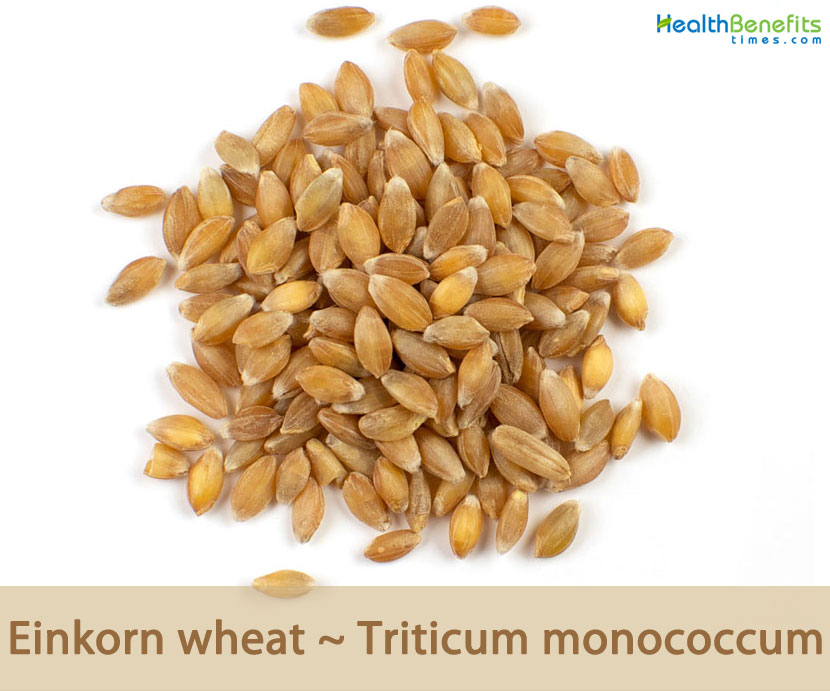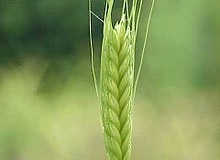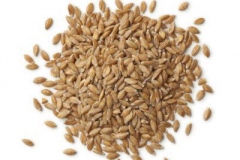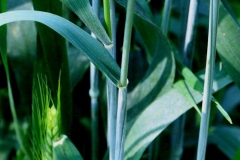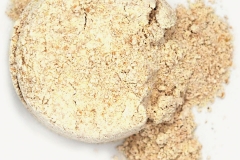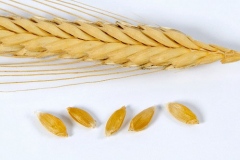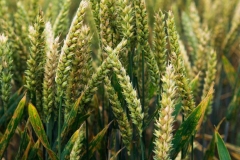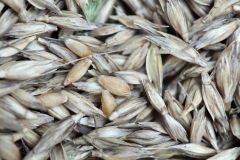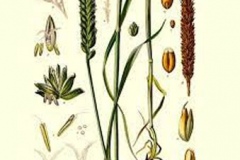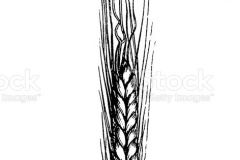| Einkorn wheat Quick Facts | |
|---|---|
| Name: | Einkorn wheat |
| Scientific Name: | Triticum monococcum |
| Origin | Caucasus, western Asia, eastern and southeastern Europe |
| Shapes | Fruit is caryopsis with adherent pericarp; hairy at apex. Hilum is linear. |
| Health benefits | Support for risk of eye disease, Reduce allergy symptoms, weight loss and prevents Type 2 diabetes. |
| Name | Einkorn wheat |
|---|---|
| Scientific Name | Triticum monococcum |
| Native | Caucasus (Armenia, Azerbaijan and Georgia), western Asia(Afghanistan, Iran, Iraq, Lebanon, Syria and Turkey), eastern (Krym in Ukraine) and southeastern Europe(Albania, Bulgaria, Greece, Montenegro and Serbia) |
| Common Names | Einkorn, Einkorn wheat, Hulled wheat, Small spelt, one-grained wheat |
| Name in Other Languages | Afrikaans: Einkorn Albanian: Einkorn, gruri tepa, tepe Amharic: Menek’ak’ati (መነቃቃት) Arabic: Einkorn (īnˌkôrn), Al qamhh el wahhid el hhabbah, qamh wahid alhaba (قمح وحيد الحبة) Armenian: Einkorn (īnkôrn) Azerbaijani: Einkorn, Təkdənli buğda Bengali: Einkorn (īnˌkôrn) Bulgarian: Ot limets (от лимец), ednozarnest limetz (еднозърнест лимец) Burmese: Maingalarpar (မင်္ဂလာပါ) Catalan: Espelta petita Chinese: Einkorn (īnˌkôrn), Hitotsubu komugi (一粒小麦 ), Yi li xiao mai Croatian: Einkorn, Jednozrna pšenica, jednozrni pir, jednozrnac Czech: Einkorn, pšenice jednozrnka Danish: Enkorn Dutch: Einkorn, Eenkoren, kleine spelt English: Einkorn, Einkorn wheat, Hulled wheat, Small spelt, one-grained wheat Esperanto: Einkorn, Unugrajno Estonian: Einkorn, Kultuur-üheteranisu Filipino: Einkorn Finnish: Einkorn, Yksijyvävehnä, einkornvehna French: Einkorn, Engrain, Petit Épeautre, Petit Epeautre de Haute Provence, blé riz, blé à un grain, ingrain Georgian: Eink’orni (ეინკორნი) German: Einkorn, Einkornweizen, ingrain, Eicher, kleiner Spelz Greek: Einkorn (īnkôrn), Monókokko sitári (Μονόκοκκο σιτάρι), tiphe Gujarati: Ā ikōrna (આઇકોર્ન) Hausa: Einkorn Hebrew: Einkorn, איינקורן, shipon Hindi: Einkorn Hungarian: Alakor Icelandic: Einkorn, Einkornahveiti Indonesian: Einkorn Irish: Einkorn Italian: Faro, Farro minore, Piccola spelta, farro piccolo, spelta minore, monococco Japanese: Eikōn (エイコーン), Hito tsubu komugi (ヒトツブコムギ) Javanese: Einkorn Kannada: Einkorn Kazakh: Einkorn Korean: Aikon (아이콘), oealmil (외알밀) Kurdish: Einkorn Lao: Einkorn Latin: Einkorn Latvian: Einkorns Lithuanian: Einkornas Macedonian: Einkorn Malagasy: Einkorn Malay: Einkorn Malayalam: Einkorn, aikēāṇ gēātamp (ഐകോൺ ഗോതമ്പ്) Maltese: Einkorn Marathi: Einkorn Mongolian: Einkorn Moroccan: Skaliah Nepali: Einkorn Norwegian: Einkorn Oriya: Einkorn Pashto: ايکنورن Persian: شرم آور, گندم تکدانه Polish: Einkorn, Pszenica samopsza, pszenica płaskurka, Portuguese: Einkorn, Trigo-candial, escanha-menor, espelta Punjabi: Einkorn Romanian: Alac Russian: Odnozernyanky (однозернянки), Odnozernjanka (Однозернянка ), PÅ¡enica odnozernjanka (Пшеница однозернянка), Odnozernyanka (Однозернянка), zanduri (зандури), psˇenica odnozernjanka Serbian: Einkorn (еинкорн), jednozrnac (једнозрнац), psˇenice jednozrnka, krupnik Sindhi: ڪنن Sinhala: Einkorn Slovak: Pšenica jednozrná Slovenian: Einkorn Spanish: Einkorn, Escaña Menor, Espadrilla, Trigo candial, Trigo carraón, Trigo de un grano, Trigo einkorn, Trigo escaña cultivada Sudanese: Leuweung Swedish: Einkorn, Enkornsvete Tajik: Einkorn Tamil: Einkorn Telugu: Einkorn Thai: Einkorn Turkish: Einkorn, Siyez, siyez, ku¨c¸u¨ k bug˘day, kaplıca bug˘dayı Ukrainian: Exinor (ехінор) Upper Sorbian: Jednozorno Urdu: Einkorn Uzbek: Einkorn Vietnamese: Cây bạch quả Welsh: Einkorn Zulu: Einkorn |
| Plant Growth Habit | Annual plant |
| Growing Climates | Occurs in field margins, grasslands and on roadsides; it favours rocky places and dry areas |
| Soil | Can survive on poor, dry, marginal soils where other varieties of wheat will not |
| Plant Size | Usually less than 70 centimeters (28 in) tall |
| Stem | Thin, firm, hairy on the knees |
| Leaf | Leaf-sheath is oral hairs ciliate. Leaf-sheath is auricles falcate. Ligule has an eciliate membrane. Leaf-blades are about 2-5 mm wide. Leaf-blade surface is puberulous. Margins of Leaf-blade are smooth, or scaberulous. |
| Flowering season | June to July |
| Flower | Inflorescence is composed of racemes. Racemes are single; bilateral; 3-4 cm long. Rhachis is fragile at the nodes and flattened; glabrous on margins, or pubescent on margins. Spikelet packing broadside to rhachis. Rhachis internodes are oblong; 2-2.5 mm long; falling with spikelet above. Spikelets are solitary. Fertile spikelets are sessile. Spikelets comprise of 1-2 fertile florets; with diminished florets at the apex. Spikelets are oblong; laterally compressed; 10 mm long; falling entire; deciduous with accessory branch structures. |
| Fruit Shape & Size | Caryopsis with adherent pericarp; hairy at apex. Hilum is linear. |
| Season | August to September |
| Health benefits |
|
| Culinary Uses |
|
Plant Description
Einkorn wheat is an annual plant that normally grows less than 70 centimeters (28 in) tall and is not very productive of edible seeds. The plant is found growing in field margins, grasslands and on roadsides and normally it favors rocky places and dry areas. It can survive on poor, dry, marginal soils where other varieties of wheat will not. Culm-nodes are bearded. Leaf-sheath is oral hairs ciliate. Leaf-sheath is auricles falcate. Ligule has an eciliate membrane. Leaf-blades are about 2-5 mm wide. Leaf-blade surface is puberulous. Margins of Leaf-blade are smooth, or scaberulous.
Flower
Inflorescence is composed of racemes. Racemes are single; bilateral; 3-4 cm long. Rhachis is fragile at the nodes and flattened; glabrous on margins, or pubescent on margins. Spikelet packing broadside to rhachis. Rhachis internodes are oblong; 2-2.5 mm long; falling with spikelet above. Spikelets are solitary. Fertile spikelets are sessile. Spikelets comprise of 1-2 fertile florets; with diminished florets at the apex. Spikelets are oblong; laterally compressed; 10 mm long; falling entire; deciduous with accessory branch structures. Glumes are similar; shorter than spikelet. Lower glume is oblong; 6-8 mm long; 1 length of upper glume; coriaceous; 2-keeled; keeled all along; 5-9 -veined. Lower glume is apex dentate; 2 -fid. Upper glume is oblong; 6-8 mm long; 0.9-1 length of adjacent fertile lemma; coriaceous; 2-keeled; keeled all along; 5-9 -veined.
Fruits
Fruit is caryopsis with adherent pericarp; hairy at apex. Hilum is linear.
Major Health Benefits of Einkorn wheat and Flour
Listed below are some of the popular health benefits of using einkorn wheat and flour
1. Lowers the risk of eye disease
Einkorn consists of dietary carotenoids, which work as antioxidants to provide relief to certain diseases including eye diseases such as macular degeneration. This was discovered after an experiment where Einkorn was observed to be increasing in carotenoid levels when sprouting, particularly when exposed to light. It’s also been exposed that there are concentrations of lutein, zeaxanthin, and β-carotene in Einkorn, which are lipophilic antioxidants that have also proven effective against eye diseases. The main function of these antioxidants is to act as a shield that absorbs the damaging effect of the light that enters the eye.
2. Reduce allergy symptoms
Einkorn is also known to be among the less allergic wheat varieties. This was first revealed in the Journal of Nutritional Science and Vitaminology after research was performed on 324 different wheat varieties sourced from different parts of the world. Research focused mostly on major wheat allergens or components of gluten such as glutenin and gliadin. This was to ensure the best screening process because these allergens were known to trigger allergic reactions in patients that were tested.
The allergens glutenin and gliadin were used as the benchmark for determining less allergenic varieties of wheat, a process which revealed Einkorn and several other wheat varieties as less allergenic. This discovery inspired the use of Einkorn and other less allergenic wheat options as mother plants for breeding to aid wheat-allergic patients with getting rid of and treating their food allergies.
3. Aids weight loss
Einkorn flour consists of several rich nutritional elements that are good for your body. Einkorn whole meal is rich in proteins and unsaturated fatty acids, fructans and trace elements, including zinc and iron. It also consists of several antioxidant compounds, which combined with its trace elements, can help you lose weight.
4. Delays development and progression of Type 2 diabetes
Einkorn flour restricts cell production that is related to glucose and fat metabolism, a process that is synonymous with the prevention or delay of diabetes development. This discovery was made after a study on ancient grains was conducted at the Department of Endocrinology and Internal Medicine at Aarhus University Hospital in Denmark.
Research investigated the effects of ancient wheat whole grain flour diets on the development and progression of type 2 diabetes, with focus on the glycemic responses. Also, an intervention study which involved the consumption of five different diets – emmer, rye flour, spelt, refined wheat and Einkorn was conducted over a period of nine weeks.
The results showed a down-regulation of hepatic genes, a phenomenon in which a cell decreases the quantity of a cellular component in response to an external variable (grain). Each diet showed a remarkable effect of the decreasing of cell production relating to glucose and fat metabolism, which is equivalent to the prevention or delay of diabetes development. Based on these findings, it’s a good idea to include ancient grains and flours, Einkorn flour specifically, in your diabetes diet plan.
5. Prevent the risk of diseases
Einkorn flour consists of copious amounts phenolic acids. This acid is known to be responsible for protecting the body from oxidative damage and diseases through the ingestion of some plants, fruits, and vegetables. Larger quantities of carotenoids have also been found in Einkorn flour than any other modern wheat flour. All of these elements have proven effective at fighting serious diseases like coronary heart disease, stroke, and cancer.
6. Low in gluten
Unlike other wheat flour varieties, Einkorn flour is low in gluten and lighter in mass. This makes it easier to digest and allows better absorption of nutrients, especially recommended for those with sensitive stomachs and endurance athletes.
Other Facts
- The straw has many uses, as a biomass for fuel etc., for thatching, as mulch in the garden etc.
- Fiber obtained from the stems is used for making paper.
- Stems are harvested in late summer after the seed has been harvested; they are cut into usable pieces and soaked in clear water for 24 hours.
- They are cooked for 2 hours in lye or soda ash and then beaten in a ball mill for 1½ hours in a ball mill.
- Fibers make a green-tan paper.
- The starch from the seed is used for laundering, sizing textiles etc.
- It can also be converted to alcohol for use as a fuel.
- It is also used for bulgur or as animal feed in mountainous areas of France, India, Italy, Morocco, the former Yugoslavia, Turkey and other countries.
References:
https://www.itis.gov/servlet/SingleRpt/SingleRpt?search_topic=TSN&search_value=42241#null
https://npgsweb.ars-grin.gov/gringlobal/taxon/taxonomydetail?id=40597
https://pfaf.org/USER/Plant.aspx?LatinName=Triticum+monococcum
https://www.cabi.org/isc/datasheet/117665
http://www.theplantlist.org/tpl1.1/record/kew-448821
https://indiabiodiversity.org/species/show/243329
http://www.narc.gov.jo/gringlobal/taxonomydetail.aspx?id=40597
https://gd.eppo.int/taxon/TRZMO
https://plants.usda.gov/home/plantProfile?symbol=TRMO22


